Bear wakes up: Modernization of Russian armored vehicles
The T-14 Armata tank is still in the early stages of development, but has already caused concern in the West, because its new layout and tower technology allow it to surpass existing combat capabilities Tanks
Despite all the recent economic turmoil, several major programs of modernization of the Russian ground forces are being implemented.
Russia today has significantly less military power than it was in the days of the Soviet Union, but, nevertheless, it still has an impressive army. The strength of the land forces of the Russian Federation is approximately 300 000 manpower. In addition, Russia retains elite airborne troops of 45000 men, while the marines subordinate to the Russian Navy have about 10000 men.
In the 90s, the Russian military was in a deep crisis due to total under-financing, radical reforms and cuts. At that time, the country was involved in two big wars with the separatists in Chechnya. The first wave of radical restructuring and reform of the land forces swept after the end of the first Chechen campaign. Then, from 2001 to 2004, the year went through a reorganization and further downsizing in an attempt to make the army more adapted to the new economic and geopolitical realities that Russia faced.
The five-day war with Georgia in the territory of the South Ossetia breakaway enclave in August 2008 demonstrated that the army was poorly prepared for modern hostilities with conventional weapons, as it had a lot of organizational flaws and experienced a shortage of certain weapons.
This forced the military leadership to launch a new wave of radical reforms, divided into three phases, the last of which is scheduled to be completed by the 2020 year. Among the main objectives of the reforms was the complete replacement of the arsenals of the Soviet era by the end of this period.
At the beginning of the reforms, the Russian defense budget was full of petrodollars, which allowed the Ministry of Defense to launch an ambitious rearmament program that embraced all branches and types of armed forces. However, the Russian economy today is in a rather deplorable state due to the low prices for oil and gas and the sanctions imposed by the West after the annexation of the Crimea in March 2014 of the year. The growing economic crisis was the reason for the reduction of Russian military revenues in 2015 by 3,8%, while the reduction in 2016 for the year was 5%.
The difficult economic situation makes it impossible to completely replace the Soviet weapons systems in the Russian armed forces by the 2020 year, so this will be a longer process, which at best can be completed no earlier than the middle of the next decade. A large number of new weapons systems are still in development or at the initial stage of mass production.
New assault vehicles
Russian airborne troops (Airborne Troops) are an independent airborne branch of the armed forces in a state of increased combat readiness. The Airborne Forces have special airborne combat armored vehicles, which can be dropped on parachute platforms from IL-76 and An-124 heavy transport aircraft for delivery to the site.
In 2004, the BMD-4 airborne combat vehicles began to receive in the Airborne Forces, but a year later their manufacturer, the Volgograd Tractor Plant (VgTZ), was declared bankrupt, and production was stopped.
Kurgan Machine-Building Plant (KMZ) received an urgent task to develop a new machine, which already in 2008 for the first time was presented under the designation BMD-4М. In fact, the car is an elongated and lightweight version of the BMP-3.
The first production units were delivered to the airborne troops in March 2015. By the end of 2016, about 60 vehicles will be delivered to the Airborne Forces to replace obsolete BMD-2 machines.
On the basis of BMD-4M was developed tracked armored personnel carrier, designated BTR-MDM "Shell"; The machine can carry 13 paratroopers.
The airborne is also armed with a self-propelled airborne anti-tank gun Sprut-SD with a 125-mm gun, which can also be used as a light amphibious tank. It was first introduced in 2005 after protracted development work, but production was also stopped after the VGTZ bankruptcy. An improved version of the Sprut-SDM1 was also developed by KMZ. He is armed with the same gun, but is based on the BMD-4M chassis.
Revolutionary armor
Tank T-14 Armata is considered the most important program for an armored vehicle. The full-scale development of this universal armored tracked platform began in the 2009-2011 years at the Uralvagonzavod Research and Production Corporation (UVZ) in Nizhny Tagil. The goal was to develop a large family of new generation combat vehicles on a common tracked chassis. The first version of the main battle tank (MBT) was first shown at the Victory Parade in Moscow in May 2015 of the year.
The design of the T-14 MBT, also known as the 148 Object, is radically different from the design of traditional Russian tanks, starting with the T-64 tank, which was born back in the 60s of the last century. The T-14 has three crew members who are placed in an armored compartment in front of the hull. The armored capsule is designed to increase the chances of survival in the event of a direct hit or fire in the engine compartment.
Like all other Russian MBTs, the T-14 tank is armed with an 125-mm smooth-bore automatic-loading gun, which can also launch guided missiles. The gun under the designation 2A82 is a completely new model. It is reported that it has significantly better performance compared with the 2A46 gun, which was installed on previous models of tanks.
Perhaps the biggest innovation of the T-14 project is the uninhabited tower. There is an assumption that its large size will make it possible to install an 152-mm gun in the future without significant modifications.
The development team has put a lot of effort to increase the combat survivability of the T-14 in the fight against modern tanks. There is not a lot of reliable information about the new complex of active protection (KAZ) "Afganit", which is one of the main elements of increasing the survivability of the new tank. It is assumed that it consists of a set of infrared, ultraviolet and radar sensors to determine the attacking projectiles and missiles with which it fights, using both means of direct and functional damage. In the event of a KAZ Afganit failure, the T-14 tank can rely on the Malachite Dynamic Protection System (DZ), covering most of its surface, including the roof of the tower. Under the DZ blocks there is a layer of composite armor of unbreakable thickness to provide additional protection.
The high mobility of the T-14 is ensured by the 12-cylinder diesel engine with an HP 1500 power. The tank also features an active suspension system.
Plans for the acquisition of the T-14 tank army units are not entirely clear. An experimental batch of tanks, which will participate in the final stage of factory testing, has been manufactured. After their completion, the vehicles will be delivered to the Russian military for military trials.
According to Vyacheslav Khalitov, deputy general director of UVZ, the plant’s production capacity allows the T-14 tank to be re-equipped with armored units of the Russian army during 5-10 years. In UVZ declare that they have the opportunity to make up to 2020 MBT before the 2300 year, but this possibility can be considered only as a purely theoretical figure, which is impossible from technical and financial points of view. However, T-14 has the highest priority among the plans for the re-equipment of armored vehicles and, of course, will receive the lion's share of funds aimed at financing the modernization of armored vehicles.
19 April 2016, the Deputy Minister of Defense, who oversees this program, Yuri Borisov, said that an order has already been placed for approximately 100 tanks. This batch is intended for field trials and, in his words, the initial limited order is consistent with the Ministry of Defense’s approach to procurement with “reasonable sufficiency”.
In May, 2015 was introduced to another member of the Armata family - the heavy T-15 BMP (149 Object). The engine of the car is installed in front, and the compartment for nine infantrymen is located in the rear part. The T-15 is equipped with a Boomerang-BM unmanned combat unit, armed with an 30-mm 2A42 cannon, a twin machine gun 7,62-mm PKT and four ATGM Cornet. It is expected that the heavy BMP T-15 will be produced in several versions, including with various weapons, including towers with 57-mm cannon and 120-mm mortar / cannon.
The T-15 heavy infantry vehicle offers the same level of protection as the T-14 tank, including the Afganit and Malachite complexes. Sources in the company UVZ also stated that the T-14 and T-15 are designed to fight in the same battle formations and will be equipped with a common tactical data exchange system. The 2015 video of the year showed an armored evacuation vehicle T-16 on the basis of the same universal tracked platform.
Bome "Boomerang" is being developed as a platform 8x8, which will perform various tasks and, ultimately, replace the outdated BTR-80
Rebirth MBT
It is clear that in the foreseeable future the Russian army will not receive a sufficient number of T-14 tanks, so it must rely on the modernization of existing armored vehicles. Its large OBT park consists of three main types: T-72, T-80 and T-90.
Tank T-90 and its modifications are considered the most modern MBT, in service with the Russian army. The base tank T-90, created in the late 80-s, is a deep refinement of the T-72B. Its production began in the 1992 year and continued until the 1998 year; It was manufactured from 120 to 160 machines. Most of these tanks are used for combat training or are in long-term storage.
The production of the modernized version of the T-90A "Vladimir" began in the 2004 year, it has a new welded turret and the B-92C2 engine with the 1000 horsepower X. The new systems also include the upgraded 2A46M-5 gun, the Buran M night sight, the advanced Blind-1M opto-electronic suppression system, and many other elements that increase mortality and survivability.
In 2006, the ESSA night sight with the Catherine-FC thermal imager matrix from the French company Thales was introduced. Until 2011, the X-NUMX T-360A tanks were manufactured with this scope, but production was then stopped due to plans for the production of the T-90 tank. UVZ also proposed an improved version of the T-14AM “Breakthrough”, but the Russian Ministry of Defense did not show any serious interest in it. However, last year there were discussions about the modernization of T-90A tanks using new systems originally designed for the T-90AM variant.
After stopping the production of T-90A, the Russian Ministry of Defense launched a program to modernize part of its T-72B MBT. The standard B3 was introduced at the end of 2011 as a more affordable alternative to restarting T-90A production.
The original upgrade in accordance with the standard B3 includes a tank overhaul, integration of the Sosna-U multichannel sight, new radio stations, a meteorological sensor and a ballistic computer. The firepower increased thanks to the integration of the 2A46M-5 gun, featuring improved gyrostabilization and more efficient automatic loading, which allows you to shoot new types of ammunition. The combat survivability of the T-72B3 tank was enhanced by the installation of DZ Kontakt-5 units.
By the beginning of 2016, the UVZ delivered 600 upgraded tanks. The T-72B3 program has reduced risks and costs compared with the T-90A project, while the upgraded tanks, according to some data, have slightly greater combat capabilities compared to the basic T-72B model. However, the survivability of the B3 remained at a low level due to the now outdated remote sensing system “Contact-5”.
At the beginning of 2016, the Department of Defense ordered a comprehensive upgrade of its T-72B MBT to an improved standard with a view to significantly lowering the overall mortality rate and increasing combat survivability. At the end of January, a contract was announced for the modernization of the first batch of X-NUMX T-32 tanks, which should be completed by the end of that year. He was followed in March by another contract, according to which the number of upgraded tanks increased to 72; according to the schedule, the last of them the army should receive at the end of 154 of the year.
The upgraded vehicle is distinguished by a more powerful diesel engine B-92C2F with 1130 hp power, an improved control system, 12,7-mm Kord machine gun mounted on the turret, a new DZ "Relikt" system and lattice screens to protect the engine compartment.
The tank fleet of the Russian army also includes a decent number of T-80 MBTs with a gas turbine engine, but there are no plans to upgrade this model; it will be decommissioned after the adoption of the T-14 tank.
Creation of BMP
Kurganets-25 (Object 695) is a new tracked BMP, developed by Kurganmashzavod. It differs from previous generations of machines in significantly larger sizes, which allows it to be compared with Western machines, for example, the American BMN M2 Bradley. As in the case of heavy infantry fighting vehicles T-15, to increase the survivability on the battlefield, saturated with ATGM and RPG, KAZ “Afganit” and DZ “Malachite” are installed on it.
Object 695 has a crew of three people and transports up to eight paratroopers. The machine is equipped with a remote-controlled Boomerang-BM combat unit with an 30-mm cannon and a twin machine gun, but the BMP is expected to receive more powerful weapons after the start of mass production.
The 693 object is the second combat vehicle based on the Kurganets-25 platform. The tracked armored personnel carrier is armed with a remote-controlled 12,7-mm machine gun, but does not have some elements of the Afghani KAZ.
In September, 2015, the concern Tractor Plants, announced that the Russian military had expressed serious concern about the large size of the Kurganets-25 family, calling it a "dream RPG shooter." However, the development of the platform will continue, and state tests will begin approximately after 2017. This means that mass production can begin at the end of the decade, provided that the Ministry of Defense approves the machine for adoption.
Russian motorized infantry units are equipped with two tracked infantry fighting vehicles — the outdated BMP-2 and better armed BMP-3. The first of them is not planned to upgrade, it is expected that it will be gradually replaced by newer models.
Until now, the BMP-3 is being manufactured, which, in service with the Russian aria, consists of 500 machines, while another batch of 100 machines was ordered in May 2015 of the year. According to the information available, the production will go on at least until the end of the decade and therefore additional orders are likely. The Russian Ministry of Defense, however, is not interested in upgrading its existing BMP-3, despite the new projects proposed by the Tractor Plants Concern, for example, the BMP-3М "Dragoon", which had the engine moved forward, which made it possible to increase the troop compartment in the aft parts of the machine.
A new generation of armored personnel carriers
Motorized infantry units of the Russian army operate a large fleet of armored personnel carriers, traditionally consisting of light wheeled armored vehicles. The military-industrial company (MIC) is the leading developer of armored personnel carriers in Russia and is currently promoting its new platform, the 8x8 Boomerang with a diesel engine with a power of 510 hp. Platform development began in the 2012-2013 years, but very little information is available about this project.
Unlike the previous models of the BTR, which are in large quantities in service with the Russian army, the new Boomerang model has an engine installed in the middle of the hull, which made it possible to install a stern ramp. All previous models had side doors, although this is considered a serious disadvantage, leading to a decrease in survivability.
At the beginning of 2016, it was announced that the tests of the BTR Boomerang began, but its production will begin no earlier than 2020, because the program does not have a high priority in the list of purchases of Russian ground forces.
The BTR-80, along with its upgraded version of the BTR-82A, are still the main types of BTR in the army. The latest version was developed by the MIC and first shown in the 2009 year. Compared with its predecessor, the BTR-82A armored personnel carrier has an increased level of survivability due to the installation of Kevlar tiles on the inner walls of the crew compartments and the landing force. Also in the car installed a new communication kit, air conditioning unit, fire extinguishing system and other systems. One of the most notable changes was the installation of a new weapon - the 30-mm 2A42 cannon with a twin PCT 7,62-mm machine gun.
Both the BTR-82AM (modernization of the existing BTR-80) and the new BTR-82A were supplied to the Russian army.
Western aid
During the presidential term of Dmitry Medvedev in 2008-2012, the Russian Ministry of Defense from time to time began to open doors to high-tech weapons from recognized Western European suppliers. Perhaps the largest such deal was the purchase for the Russian army of an LMV light armored car by the Italian company Iveco. After several years of testing, the first contract for the licensed assembly of this model in Russia was signed in 2011. In accordance with the plan, 358 purchased LMV M65 armored cars, which received the name “Lynx” in Russia. At that time, long-term plans included the purchase of a total of 1775 machines.
The contract on the armored car LMV was signed after the first disappointments caused by the shortcomings of the armored Tiger developed by the local company GAZ, but later it itself was subjected to certain criticism. The licensed assembly of the first batch of LMV M65 was completed in November 2014 of the year, but there were no new orders for the LMV machine. In 2013, high-ranking sources at the Ministry of Defense stated that no further purchases were foreseen, since tests and preliminary exploitation demonstrated that the vehicle did not meet all the requirements of the Russian military.
Another major contract with the Western company was signed in 2011 year, the purpose of which was to improve the quality of the combat training of the Russian army. For the construction of a large training center in Mulino in 370 km from Moscow, the German company Rheinmetall was chosen.
The contract for the construction of a center capable of training military personnel up to 30000 per year was estimated at 100 million euros. The landfill in Mulino with a total area of 500 km2 will allow to conduct combat training of the whole motorized infantry brigade in a wide range of combat scenarios. Using simulated hostilities and modern equipment, instructors will be able to assess in detail the fighting qualities of the units involved in the training, right down to the individual soldier.
After the EU imposed sanctions on Russia in connection with its participation in the crisis in Ukraine and the annexation of the Crimea, Rheinmetall unilaterally decided to terminate the contract, despite the stipulation in the sanctions, which allows for the complete completion of already concluded and active contracts.
Infantry mobility
Russia began to use various armored personnel carriers of the infantry after the war in Chechnya highlighted the urgent need to have armed infantry units armed with well-protected vehicles capable of withstanding explosions on improvised explosive devices (IED) and firing from small arms weapons.
The Russian military bought two main models of infantry vehicles. The first model is an armored Tiger 4x4 with a diesel engine manufactured by GAZ. There are several options for this vehicle, including armored and armed versions. In the framework of the second project "Typhoon" a protected vehicle was created for the transport of personnel, which will be used in light-duty infantry brigades. The Typhoon protected vehicle has an armored body, but has no weapons, since it is intended only for the transport of troops. The Tayfun-K 6x6 armored car was designed by the Kama Automobile Plant, and the Typhoon-U was built by the Ural auto plant. Both vehicles, which can accommodate 16 soldiers, are already being produced for the Russian military. The booking level roughly corresponds to the STANAG 4 NATO Standard 4569 Level.
The heavy-armored infantry fighting vehicle T-15 (pictured) enters the family on the basis of the Armat’s universal tracked platform.
Artillery continues to live
The Russian army inherited the traditions of the Soviet artillery school, as evidenced to a large extent by the massive use of artillery systems in eastern Ukraine and Syria. The army is armed with a fairly wide range of powerful and reliable artillery systems. Self-propelled systems include 203-mm Peony, 152-mm Hyacinth-S, Msta-C and Acacia, as well as 122-mm Carnation, while towed howitzers include 152-mm Hyacinth-B, Msta-B and 122-mm models D-30.
Coalition-SV, perhaps, is the most famous self-propelled unit, which is close to adoption. The development of 152 crawler howitzer began in 2002; It was first shown to the public in May 2015 at the Victory Parade in Moscow.
In accordance with the current plans, the Coalition-SV should replace the Msta-C howitzer. It has a completely new 2A88 gun with an automatic loader that allows you to achieve a quick rate of 5-10 minute shots. The initial plans envisaged its installation on the Armat’s chassis, but when the Coalition-SV entered the Parade, it turned out that the gun was based on the chassis of the T-90 tank.
Development and testing are at an advanced stage and sources in the Russian Ministry of Defense hint that the system will be adopted by the army at the end of 2016.
Another new system is the Khost self-propelled artillery gun. Being the development of an obsolete howitzer Carnation, this gun mount has a new 120-mm gun 2A80-1 in combination with a completely new fire control system. Hosta’s first howitzers were delivered in 2010; The Russian army has at least 20 upgraded systems, modified from existing Gvozdika howitzers.
From 2010 onwards, the Russian military has also been acquiring a self-propelled Vienna machine with an 120-mm cannon / mortar, which can fire a variety of ammunition. Traditionally in the Russian arsenal there are rocket salvo systems (MLRS). The arsenal consists of three main systems: 122-mm Grad, 220-mm Hurricane and 300-mm Smerch. The Tornado modernization program provides for the revision of all three MLRSs, which will increase their accuracy and mortality.
Tornado-G, based on the MLRS Grad, has a new fire control system, which allows you to reduce the time of preparation for launches and quickly perform a change of position. The system entered service in 2011 year.
Tornado-S is a similar modernization of the MLRS Smerch. Both upgraded systems for some reports received new missiles with higher mortality. The Tornado-M1 is the newest MLRS that can simultaneously launch 220-mm Hurricane missiles and Smerch 300-mm missiles. In total, 2020 MLRS should be ordered before 700, most of which are expected to be upgrades to existing systems.
BMP Kurganets-25 has a crew of three people and can carry up to 8 infantry. The machine is armed with a 30-mm 2A42 cannon and a 7,62-mm machine gun paired with it in a remote-controlled combat module Boomerang-BM
Kurganets-25 BTR (693 Object)
Model BRAM based platform Kurganets-25
Materials used:
www.shephardmedia.com
gurkhan.blogspot.ru
otvaga2004.mybb.ru
www.wikipedia.org
en.wikipedia.org
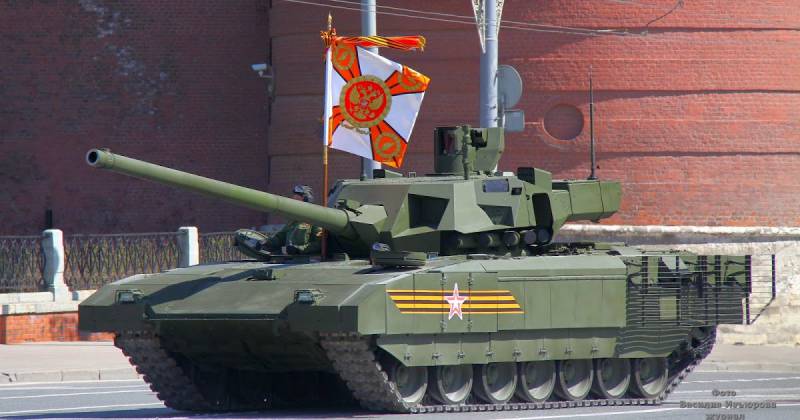
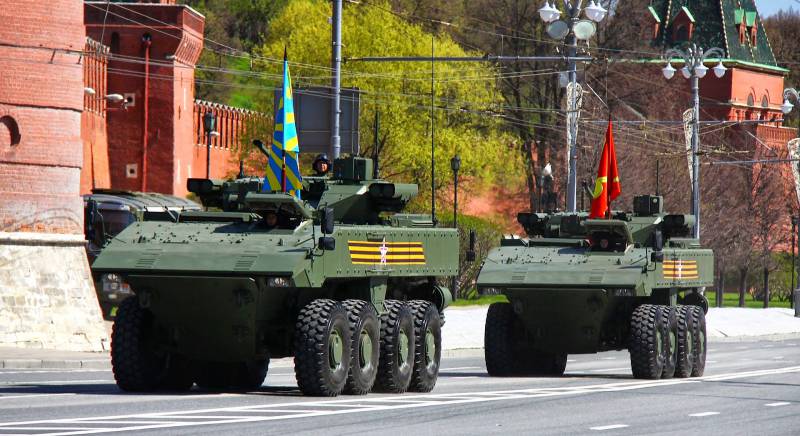
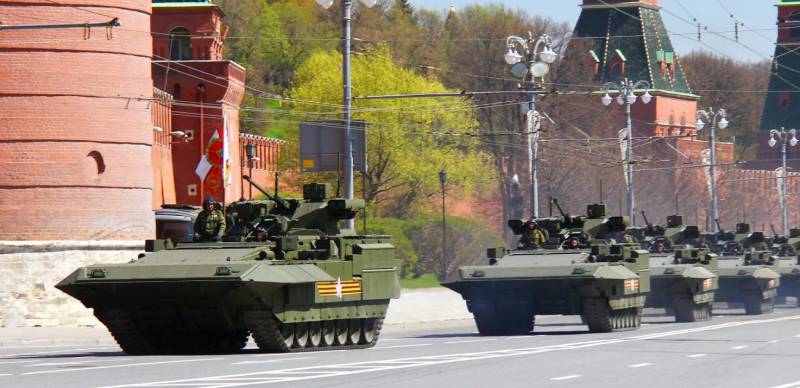
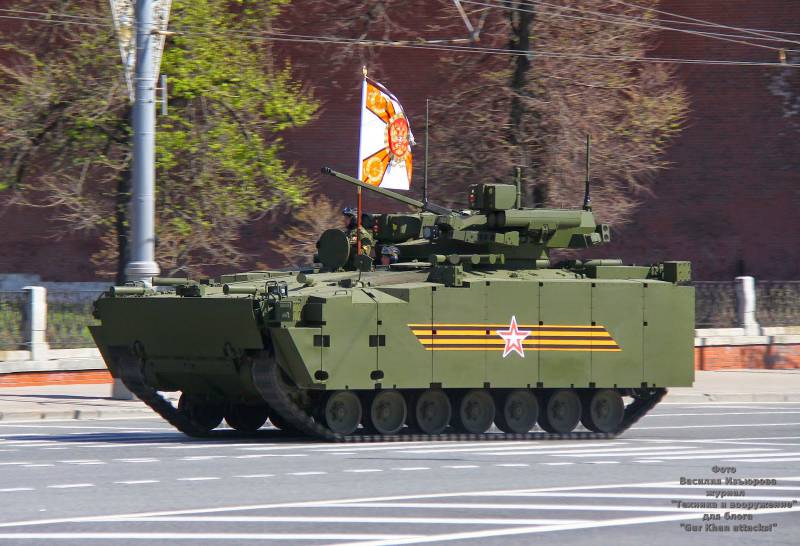
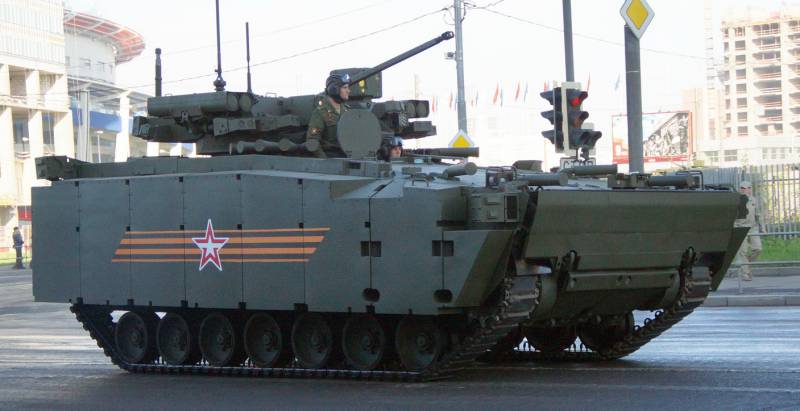
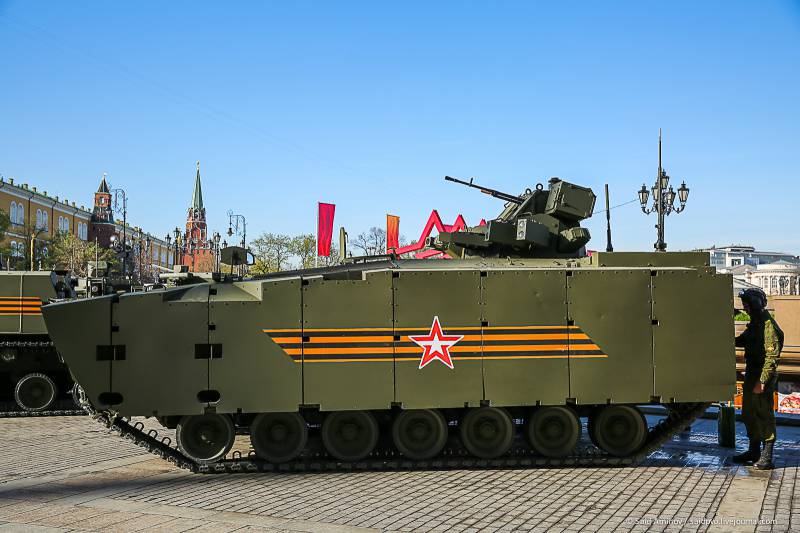
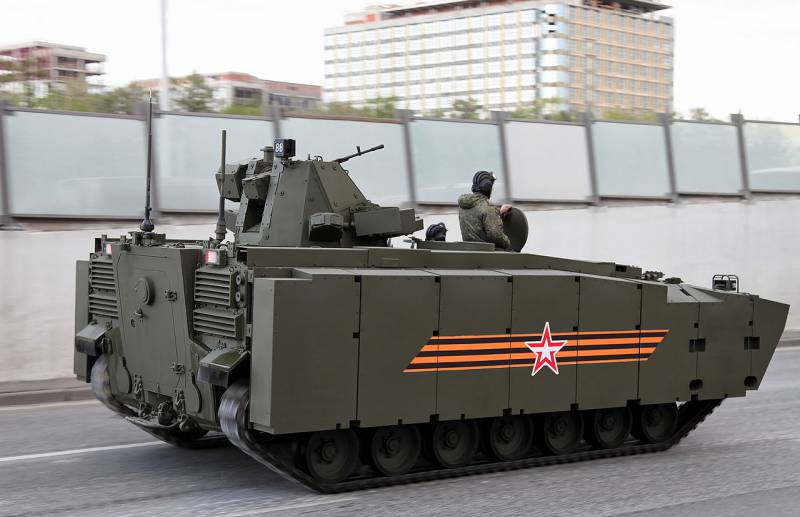
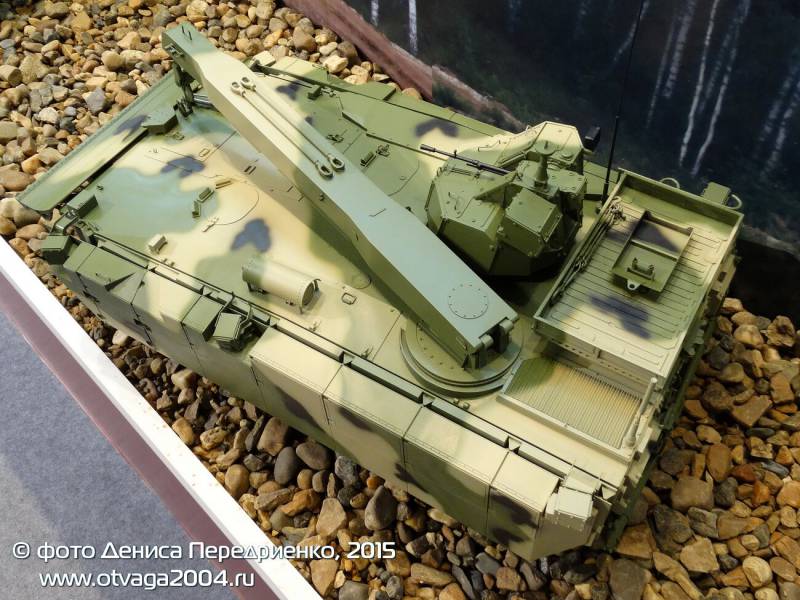
Information